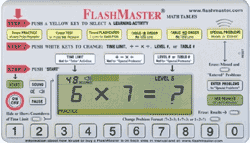"Let me do the multiplication part," she says. "I love multiplication!"
We're currently learning about fractions and decimals and percents. Becky has auditory processing delays so she can't remember all the steps or formulas involved in solving the problems. Every day I go through each problem with her step-by-step. She tracks along with me and seems to understand the basic concepts, but she wouldn't be able to do the complex problems on her own.
Multiplication, though? She's got that nailed.
She actually knows her facts better than I do. I never can remember... what's 7x6 and 8x7?
Let me think just a minute.
Oh, yes... 42 and 56.
Dare I admit that I got that by counting forward from 6x6 and 7x7? Math is not my strong suit. And I think I know why. Having to calculate the basic facts while working more complex problems can get confusing and frustrating. Memorizing those tables by rote is so important.
I can see that now. Too bad I didn't when I was 10.
My daughter is 17, so we've been working on the math facts for several years. That's normal for her. Everything she learns has to be repeated many, many times over many months. And so, I utilized a wide variety of systems to help her memorize the multiplication tables. We tried:
- Flash Cards... which might have eventually worked, if I hadn't gotten so utterly bored going over and over them.
- Multiplication Songs... and Becky cheerfully memorized the tunes but got the numbers garbled.
- Drill Worksheets... which quickly got tedious and actually seemed to reinforce mistakes as Becky might write a wrong answer and not realize it.
- Mnemonic Stories... which were very cute and worked temporarily, but didn't seem to stick long-term.
While she did know some of her facts, Becky often had to resort to counting on her fingers or making tick marks on a paper to figure out the harder ones.
So how did she finally nail them? I have to give credit to a handy-dandy device that Sonlight carries called FlashMaster.
 When Becky reached high school age, I started giving her a list of assignments and tasks she needed to complete independently each day before she could say she was "done with school" for the day. I put FlashMaster on her list. I showed her how to set the device at the lowest/easiest level and told her I wanted her to go through the sequence twice each day. Once she started getting 100% on that level, she was to change the settings to move up to the next level. And that was it! After a few months I noticed she was remembering the answers. No more having to stop and figure it out in the middle of a problem.
When Becky reached high school age, I started giving her a list of assignments and tasks she needed to complete independently each day before she could say she was "done with school" for the day. I put FlashMaster on her list. I showed her how to set the device at the lowest/easiest level and told her I wanted her to go through the sequence twice each day. Once she started getting 100% on that level, she was to change the settings to move up to the next level. And that was it! After a few months I noticed she was remembering the answers. No more having to stop and figure it out in the middle of a problem.
Now that she's got the multiplication tables memorized I told her I wanted her to start over with division. She moaned at the thought. "Look!" I told her. "Division is just backwards multiplication. You know the multiplication answers, so you'll know the division answers, too." That hadn't occurred to her. For most kids that step wouldn't be necessary. But for her, it's a good way to reinforce and review what she's learned.
By the time she's done she will literally know her multiplication facts forwards and backwards.
Now, if there were only such a thing for counting money and telling time.
Enjoying the adventure,
~Karla Cook
Lifelong Learner





[…] one-by-one with her sitting beside me following along. She had memorized the multiplication tables (using the Flashmaster device) so she was able to work the basic math steps as we came to them, though I knew she wouldn’t […]
Thank you for this post! I bought the FlashMaster last year, but never really used it until the past few weeks. I realized my 9-year-old is behind on knowing the basic math facts (even though Miquon math and his natural gifts have made him a whiz at math CONCEPTS). He balks at doing FlashMaster drills each day, but I am insisting... and it's encouraging to hear your success story about it.
Hi I would love to know what you chose for curriculum for math 7- high school. Thank you